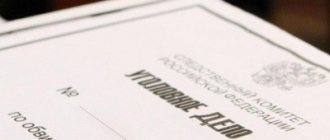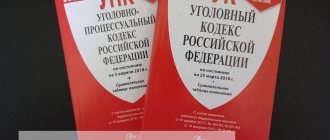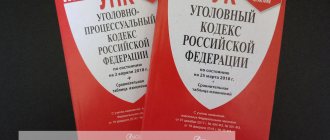No driver is immune from being involved in a traffic accident. And if the result is serious harm to health in an accident, the conversation inevitably turns to criminal liability for the citizen who was driving. Its degree depends on various factors.
The physical condition of the driver and further actions on his part matter. Often, adjustments are made for the road situation and the behavior of the victim himself. But be that as it may, it is always worth keeping the consequences in mind.
This material will consider the problem of serious bodily injury in an accident with victims on all sides. Materials from judicial practice will complement the picture. Finally, when a car owner finds himself in a difficult situation, the recommendations offered can help.
Serious bodily injury in a road accident, Article 264 of the Criminal Code of the Russian Federation
When serious harm to health has been caused as a result of an accident, you need to think about criminal liability. In many ways, the qualification of an act depends on whether it was committed intentionally or not.
After all, it happens that a deliberate collision with a pedestrian, a citizen towards whom there is hostile relations, is permitted deliberately out of a sense of revenge or other motives. In such a situation, Art. 111 of the Criminal Code (Criminal Code of the Russian Federation), namely paragraph “c” of Part 2. It states that bodily injuries are inflicted in a generally dangerous way. And the use of motor vehicles falls well within this case.
If, as a result of the described criminal actions, a person dies after a while, then the conversation is already about murder. Responsibility for it comes under Article 105 of the Criminal Code of the Russian Federation.
In the event that an accident with serious bodily injury occurs unintentionally, the Criminal Code of the Russian Federation has a separate article - 264. It consists of 6 parts that determine the punishment for the driver depending on several qualifying criteria.
Factors that increase liability:
- alcohol intoxication, being under the influence of drugs or psychotropic drugs;
- leaving the scene of an accident;
- death;
- the presence of two or more victims.
For criminal prosecution, it does not matter who the injured party is. This could be another driver, a passenger, or a pedestrian.
In addition, punishment is inextricably linked with non-compliance with traffic rules. Therefore, in their verdicts, courts describe in detail which points of the rules the accused violated.
How is harm to health classified in a road accident?
In a situation where people have been injured in a road accident, the conversation almost always turns to personal injury. After all, as a result, different parts of the body and organism are injured to a greater or lesser extent.
The degree of harm caused to health in a road accident is determined by several factors. Among them, in the first place are the danger of the injuries to life and the degree of loss of ability of the victim to work.
Depending on the severity of the injuries, liability differs, which can be both administrative and criminal. Additionally, the culprit of the accident has an obligation to compensate the victim for material and moral damage.
Easy
The definition of this type of harm is contained in the note to Art. 12.24 Code of Administrative Offenses of the Russian Federation. According to this standard, minor injuries should be considered a short-term health disorder or minor loss of ability to work.
Additionally, you must refer to the Order of the Ministry of Health of the Russian Federation dated April 24, 2008 No. 194n (hereinafter referred to as Order No. 194n). Clause 8.1 states that the period of sick leave is up to three weeks.
Minor abrasions, bruises, bruises, and scratches do not count as bodily injury. Accordingly, there will be no punishment.
In this case, the conversation turns to administrative responsibility. Moreover, it differs depending on who is involved in the incident.
When the driver is mentioned, the punishment is prescribed in Part 1 of Art. 12.24 Code of Administrative Offenses of the Russian Federation. This can be either a fine in the amount of 2500 - 5000 rubles, or deprivation of rights for 1-1.5 years.
However, harm is often caused by the actions of pedestrians and other road users. For example, a person suddenly ran out onto the road. The driver had to brake sharply, causing him to hit the steering wheel.
Here administrative responsibility is already spelled out in Part 2 of Art. 12.30 Code of Administrative Offences. The amount of monetary sanctions for minor and moderate injuries is the same - 1000-1500 rubles.
Average
It is characterized by a non-life-threatening long-term health disorder or permanent disability of at least 1/3. The period the victim is on sick leave is 21 days or more.
Administrative responsibility is also provided here. According to Part 2 of Art. 12.24 of the Code of Administrative Offenses, the driver faces a fine in the amount of 10,000–25,000 rubles or temporary withdrawal of his driver’s license for 1.5-2 years.
It often happens that as a result of additional medical examination, moderate injuries are transformed into serious ones. Then a criminal case is initiated under the first or second part of Art. 264 of the Criminal Code of the Russian Federation with the simultaneous closure of administrative proceedings.
Heavy
Causing it already results in criminal liability. The subject of the crime is the guilty driver of a car or other vehicle for which a license is required to drive.
In paragraph 6.1 of Order No. 194n, grievous bodily harm is characterized as injuries that create a direct threat to life. The same applies to injuries, as a result of which a dangerous condition for a person develops over time. In turn, in Art. 111 of the Criminal Code of the Russian Federation contains another sign of harm - permanent loss of ability to work by more than a third.
The presence of serious harm to health and the sources of its origin are determined by the examination. The results obtained are then described by the court in its verdict.
Fatal
Often, as a result of the injuries received, a person dies after some time in the hospital. In this case, the task of the investigation and the court is to determine the causal relationship between the injuries and the death that occurred.
In this case, it is also impossible to do without examination. Its conclusions serve as the basis for reclassifying the crime from Part 1 of Art. 264 into parts three through six, depending on additional features.
Naturally, when a fatal accident occurs, the liability for the defendant increases. And deprivation of liberty is a very real scenario for further developments.
Nuances
The owner of a car involved in an accident with victims does not always have to bear responsibility for what happened. Exceptional cases are when:
- the accident occurred as a result of the theft of a vehicle, and the fact that the driver was not the owner of the car has been proven;
- the accident was influenced by natural or some force majeure, for example, if a pedestrian fell under the wheels through his own fault;
- the car was driven by another person who is not the owner of the vehicle;
- the accident occurred as a result of vehicle breakdowns (the court will take this into account as a mitigating circumstance), and responsibility can also be shifted to the agency that carried out the technical inspection of the vehicle.
In some cases, collisions with pedestrians become a misunderstanding in which both are to blame, but the driver still has to bear responsibility.
| Question | Answer |
| What degrees of harm to health in a road accident exist? | Experts distinguish three degrees of severity of harm: mild, moderate and severe. |
| What determines the severity of harm to health? | From the time of loss of ability to work, from the duration of therapy, from further consequences. |
| Where can a victim of an accident apply for compensation for harm? | To the culprit's insurance company, if the amount of coverage is insufficient, then to the court |
| What to do if the person at fault for the accident does not have compulsory motor liability insurance? | File an application with the Russian Union of Auto Insurers or the judicial authorities. |
| What is the statute of limitations for cases of personal injury resulting from an accident? | The statute of limitations is 2, 6 and 10 years for light, moderate and severe bodily harm, respectively. |
Comments Showing 0 of 0
Criteria for causing serious harm to health in an accident
Some of them are indicated in Art. 111 of the Criminal Code of the Russian Federation. It specifically mentions loss of speech, vision or hearing. The same applies to the loss of an organ in the body or its basic functions. Serious bodily harm also includes termination of pregnancy or permanent mental illness.
A more detailed list of injuries is given in Order No. 194n. There is no need to list them all. Therefore, we will focus only on the main ones.
External injuries:
- head wounds;
- loss of vision in one or both eyes;
- partial deafness;
- loss of limb;
- facial disfigurement.
However, severe injuries are often invisible to the naked eye. No less dangerous are those that arise from within. Their presence is indicated by the victim’s screams and loss of consciousness.
Damage to internal organs:
- fractures of the skull and its bones;
- intracranial injuries;
- penetrating wounds of the neck, thyroid gland;
- fractures in the cervical spine;
- penetrating wounds of the chest, abdomen;
- numerous rib fractures;
- rupture of large blood arteries;
- heavy blood loss;
- acute heart failure.
One of the criteria for serious harm to health is permanent loss of general or complete professional ability to work. The degree of its loss is determined according to the rules approved by government decree No. 789 of October 16, 2000.
What is the penalty for an accident involving serious bodily injury?
When an accident causing grievous bodily harm was the result of intent, then the culprit, by virtue of paragraph “c” of Art. 111 of the Criminal Code of the Russian Federation faces up to 10 years in prison. In addition, the court may impose a restriction of freedom for up to two years.
It is worthwhile to dwell in more detail on the sanctions contained in Art. 264 CC. The easiest way to present them is in the form of the table below. The severity of the punishment depends on the specific part of the article, the presence of mitigating and aggravating circumstances.
Courts often replace actual deprivation of liberty with suspended sentences for the accused. And such sentences will be illustrated further in the text of the material by cases from judicial practice.
In addition, there are many examples when, under Part 1 of Art. 264 of the Criminal Code, the criminal case is generally terminated. The basis is reconciliation of the accused and the victim, as well as compensation for damage from an accident.
| Part of the article | Qualification | Restriction of freedom | Arrest | Forced labor | Deprivation of liberty |
| Serious bodily harm | |||||
| 1 | No qualifications | up to 3 years | up to 6 months | up to 2 years | up to 2 years |
| 2 | Alcohol, drugs, leaving the scene of an accident | _ | _ | up to 5 years | from 3 to 7 years |
| Death | |||||
| 3 | No qualifications | _ | _ | up to 4 years | up to 5 years |
| 4 | Alcohol, drugs, leaving the scene of an accident | _ | _ | _ | from 5 to 12 years |
| Death of two or more persons | |||||
| 5 | No qualifications | _ | _ | up to 5 years | up to 7 years |
| 6 | Alcohol, drugs, leaving the scene of an accident | _ | _ | _ | from 8 to 15 years |
An additional penalty for the driver is deprivation of license for a period of up to 3 years. If a citizen is accused under Part 1 of Art. 264 of the Criminal Code of the Russian Federation, then the issue with the certificate is resolved at the discretion of the court.
What is the payment period?
After the court decision, you can pay immediately, but it is better to wait for the decision to come into force. It will come into force in a month if it is not appealed to a higher court.
The plaintiff may ask the court for immediate enforcement of the decision, but such a request will need to be supported by evidence that delay in enforcement would have adverse consequences for the plaintiff.
Well, if you decide not to pay for as long as possible, then there are no deadlines, everything will depend on your property and financial situation, the bailiffs and the actions of the collector.
What can mitigate or increase guilt?
The table shows the maximum limit of sanctions for each part of Art. 264 of the Criminal Code of the Russian Federation. However, when making a final verdict, courts take many factors into account. They speak both for the accused and against him.
Additionally, the road situation is analyzed, including weather conditions and illumination of the area where the accident occurred. The actions of the victim can also play an important role.
Mitigating circumstances include:
- committing a crime for the first time;
- pregnancy of the female driver, presence of dependent small children;
- providing the victim with first aid at the scene of the incident;
- confession, providing full assistance to the investigation;
- voluntary compensation for damage caused.
Given in Art. 61 of the Criminal Code of the Russian Federation, the list of mitigating circumstances is not exhaustive. Often the identity of the accused, characteristics about him at his place of work and residence are taken into account.
In turn, the range of aggravating circumstances is contained in Art. 63 of the Criminal Code of the Russian Federation. The driver's drunken state, drug intoxication or leaving the scene of the accident was noted above.
Here you can add the presence of an outstanding criminal record, as well as the onset of serious consequences. They mainly refer to fatal accidents.
What to do if you are guilty?
- Cooperate with the court and investigation. By law, cooperation during the proceedings reduces your maximum sentence regardless of aggravating circumstances;
- Conduct examinations. Every little detail matters. Check the road, the car, and the circumstances of the accident. Every little thing can be critical;
- Hire a competent auto lawyer. A good defense will make all the difference in a trial;
- Make peace with the victim. Try to smooth out the conflict as much as possible and resolve all disputes outside of court.
How moral and material damage is compensated
Bringing a citizen to administrative or criminal liability does not relieve him of the obligation to compensate for the harm caused to the victim and his relatives. The procedure itself largely depends on whether the culprit had a compulsory motor liability insurance policy.
Currently, the law sets a threshold for payments depending on how serious the injuries become. Here are the specific numbers.
Compensation limits for personal injury:
- 500,000 rub. – in case of death, the onset of 1st group of disability, for a disabled child;
- 350,000 rub. – in the case of disability group 2;
- 250,000 rub. – for disabled people of group 3.
It is clear that insurance does not always cover the full damage caused. In this case, the difference is recovered from those involved in the accident. If he did not have insurance, the citizen is responsible in full on his own. The situation when the culprit of an accident dies deserves special attention.
In serious incidents, harm is caused to both people and vehicles. For cars, the maximum insurance coverage is limited to 400,000 rubles. And compensation is provided through the organization of repairs under OSAGO. When restoring the car is more expensive, the missing amount is recovered from the culprit.
Moral injury
It is indemnified regardless of health damage coverage. Moreover, the recovery of the moral component in an accident is not related to the presence of guilt.
Both the victim and his immediate family have the right to receive damages - in the case of death. The specific monetary amount is determined independently by the interested party based on the physical and mental suffering suffered.
When a criminal case is still under investigation against the culprit of the accident, moral damages are recovered through a civil claim. A decision on it is made simultaneously with the sentencing.
Who gets reimbursed?
Initially, insurance compensation for health damage under compulsory motor liability insurance is paid exclusively to the party injured in the accident.
But if the victim died in an incident, the right to payment of compensation arises for other persons in the event of the loss of a breadwinner (Article 1088 of the Civil Code, paragraph 6 of Article 12 of Federal Law No. 40), including:
- disabled dependents of the deceased (for example, minor children or adults in training);
- children born after the death of the breadwinner;
- parents, spouse and other non-working family members of the deceased, if they are caring for young children, grandchildren, brothers or sisters who were dependent on the deceased.
Serious harm to health in an accident: judicial practice
Relatively recent precedents indicate that in the absence of aggravating circumstances, courts are loyal to those responsible for road accidents. Often real terms of imprisonment are replaced by suspended ones. In some cases, a court fine is even applied.
When charges are brought under Part 1 of Art. 264 of the Criminal Code of the Russian Federation, in many situations criminal prosecution is terminated. This is facilitated by reconciliation and full compensation for harm.
When it comes to driver's license revocation, courts rarely impose a maximum of 3 years. The relationship between machine control and work activity is also taken into account. For your reference, the following are several judicial precedents.
Reconciliation of the parties and termination of the criminal case
Fedorov, driving in reverse from the supermarket territory, caused an accident at a pedestrian crossing. As a result, the woman received a traumatic brain injury, broken ribs and other injuries. A criminal case was initiated against Fedorov under Part 1 of Art. 264 of the Criminal Code of the Russian Federation.
During the court hearing, the victim filed a motion to terminate the proceedings in connection with reconciliation with the accused and full compensation by the latter for the damage caused. The prosecutor did not object to this.
As a result, by a decision of the Sovetsky District Court of Krasnodar dated May 29, 2020, in case No. 1-369/20, the criminal case against Fedorov was terminated. The preventive measures introduced were also cancelled.
Punishment if the driver is drunk
Citizen Savelyeva, while intoxicated and driving at excessive speed, hit Konstantinov, who was walking along the sidewalk. At the same time, the accused had no rights.
As a result, the victim received numerous injuries, including amputation of a lower limb. When imposing the punishment, the Khabarovsk District Court of the Khabarovsk Territory took into account the lack of a driver’s license and attempts to make amends.
As a result, by a verdict dated May 29, 2020, in case No. 1-193/2020, Savelyeva was sentenced to 3 years in prison on the basis of paragraph “a” of Part 2 of Art. 264 of the Criminal Code of the Russian Federation. There is a ban on driving for the same period. In addition, 2 million rubles were recovered in favor of the victim as moral damages.
Bodily injury and leaving the scene of an accident
Leonov lost control and crashed into a tree. As a result, a passenger who was in the car at the time was injured. The accused did not provide assistance to the victim and fled the scene of the accident.
During the trial, the victim filed a motion to terminate the criminal case due to reconciliation. However, the court considered it necessary to still sentence Leonov under paragraph “b” of Part 2 of Art. 264 CC.
By the verdict of the Bezhetsk Interdistrict Court of the Tver Region dated May 25, 2020, Leonov was sentenced to 3 years of imprisonment with a two-year probationary period. A 2-year deprivation of rights followed.
Death of a passenger
Due to a careless maneuver, Dunaev caused the car to overturn. The passenger who was there died as a result of his injuries.
When assigning punishment under Part 3 of Art. 264 of the Criminal Code of the Russian Federation, the Kurganinsky District Court of the Krasnodar Territory took into account mitigating circumstances in relation to Dunaev. This is the commission of a crime for the first time, admission of guilt and repentance, as well as partial compensation for damage to the family of the victim.
By the verdict of May 27, 2020, in case No. 1-120/2020, Dunaev was sentenced to 2 years of suspended imprisonment. He was suspended from driving for the same period of time.
Replacing imprisonment with a court fine
Nikitina drove her car into the oncoming lane and collided with another vehicle. As a result, two of Nikitina’s passengers died from serious bodily injuries.
However, the investigator petitioned the court to terminate the criminal prosecution under Part 5 of Art. 264 of the Criminal Code of the Russian Federation with the imposition of a court fine on the accused. Nikitina’s pregnancy, the lack of facts of bringing her to administrative responsibility, and compensation for damage to the injured party were taken into account.
As a result, by a decision of the Sukhinichesky District Court of the Kaluga Region dated May 21, 2020, in case No. 1-1-38/2020, the criminal case against Nikitina was canceled. At the same time, she was ordered to pay a court fine in the amount of 150,000 rubles by a certain date.







